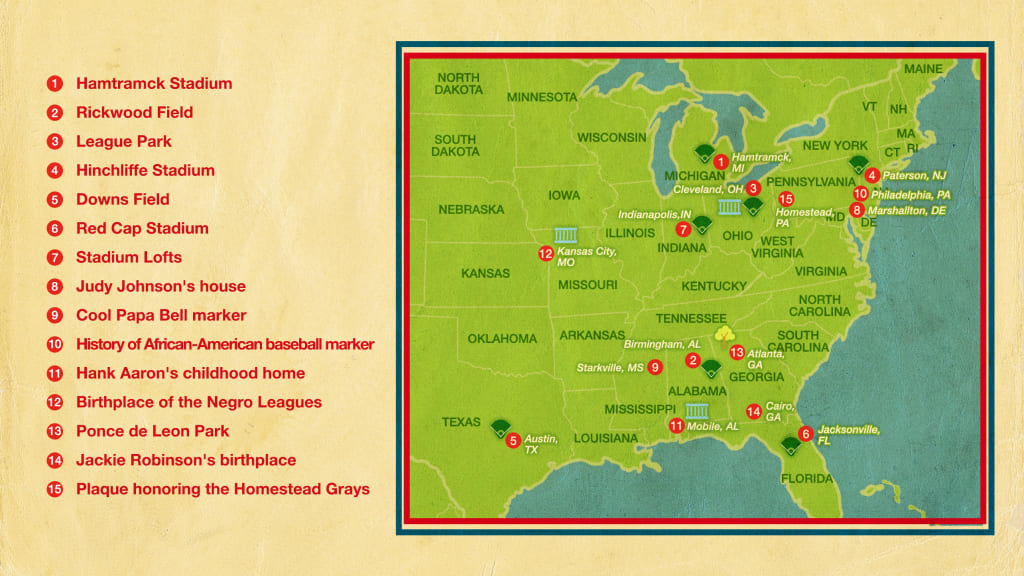
A version of this story was originally published in February 2020.
The Negro Leagues are responsible for some of the greatest moments, players and stories in baseball history. Birthed during a meeting at a Kansas City YMCA in 1920, the Negro National League and others that followed gave the country's greatest African-American players like Satchel Paige, Josh Gibson, and Buck Leonard a place to show off their skills.
While much of the Major Leagues' biggest moments have been recorded and kept, archived and collected, little remains from the Negro Leagues. Sure, there are the stories: Paige sitting the outfield down to strike out the side or tales of how far Gibson was able to smash the baseball. But so much of it is gone -- teams barnstormed throughout the country and statistics and mementos were hard to track down.
Fortunately, not all of it is gone, with small pockets of history often available if you're willing to drive by and look out the window. So, next time you're on a road trip, set your maps for one of these 15 locations.
Hamtramck Stadium - Hamtramck, Mich.
There was a time when people thought this stadium was already gone. But as researcher Gary Gillette discovered, many had confused Hamtramck Stadium -- built in 1930 and home to the Detroit Stars -- with nearby Keyworth Stadium.
Obscured by vines and weeds, the grandstand rotted in what’s now called Veterans Park. Few remembered the legends like Hall of Fame outfielder Turkey Stearnes who played here. But the field has been rehabilitated, with Detroit rock n' roll legend and baseball fan Jack White organizing pickup games to raise funds.
Rickwood Field - Birmingham, Ala.

The oldest baseball stadium in the country was once the home stadium for the Birmingham Black Barons, where players like Paige, Willie Mays, Mule Suttles and Dan Bankhead -- the first African-American pitcher to make the Major Leagues -- patrolled the field.
While many of the existing Negro League stadiums now are nothing more than a grass field with a grandstand or wall left remaining, Rickwood Field hosts games every year as a kind of "living museum." In 2024, the Cardinals and Giants will play on the hallowed grounds.
League Park - Cleveland, Ohio
Home to the short-lived Cleveland Buckeyes for eight years in Cleveland's historic Hough district, including the Buckeyes' Negro World Series title in 1945, there was a time when League Park was about to go the way of many other Negro Leagues stadiums.
But the space has been rejuvenated and is once again home to local baseball games. The field was converted to artificial turf and the old ticket office became the home of the Heritage Baseball Museum.
The museum is open Thursday through Sunday, 9 a.m. to 3 p.m.
Hinchliffe Stadium - Paterson, N.J.
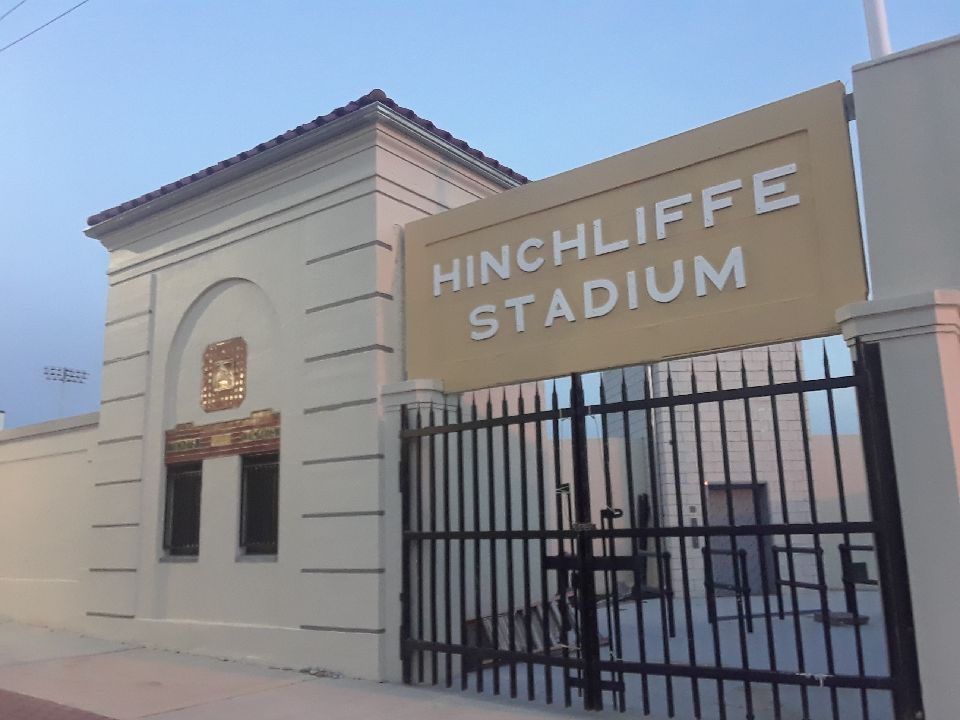
Built in 1932, Hinchliffe Stadium soon became the full-time home for the New York Black Yankees. The New York Cubans also played their home games there for two seasons.
Some of the Leagues' best players passed through the stadium's gates, including Monte Irvin and Cool Papa Bell, but the true star of the city was Larry Doby, who grew up in Paterson playing baseball and football long before he reached the Major Leagues.
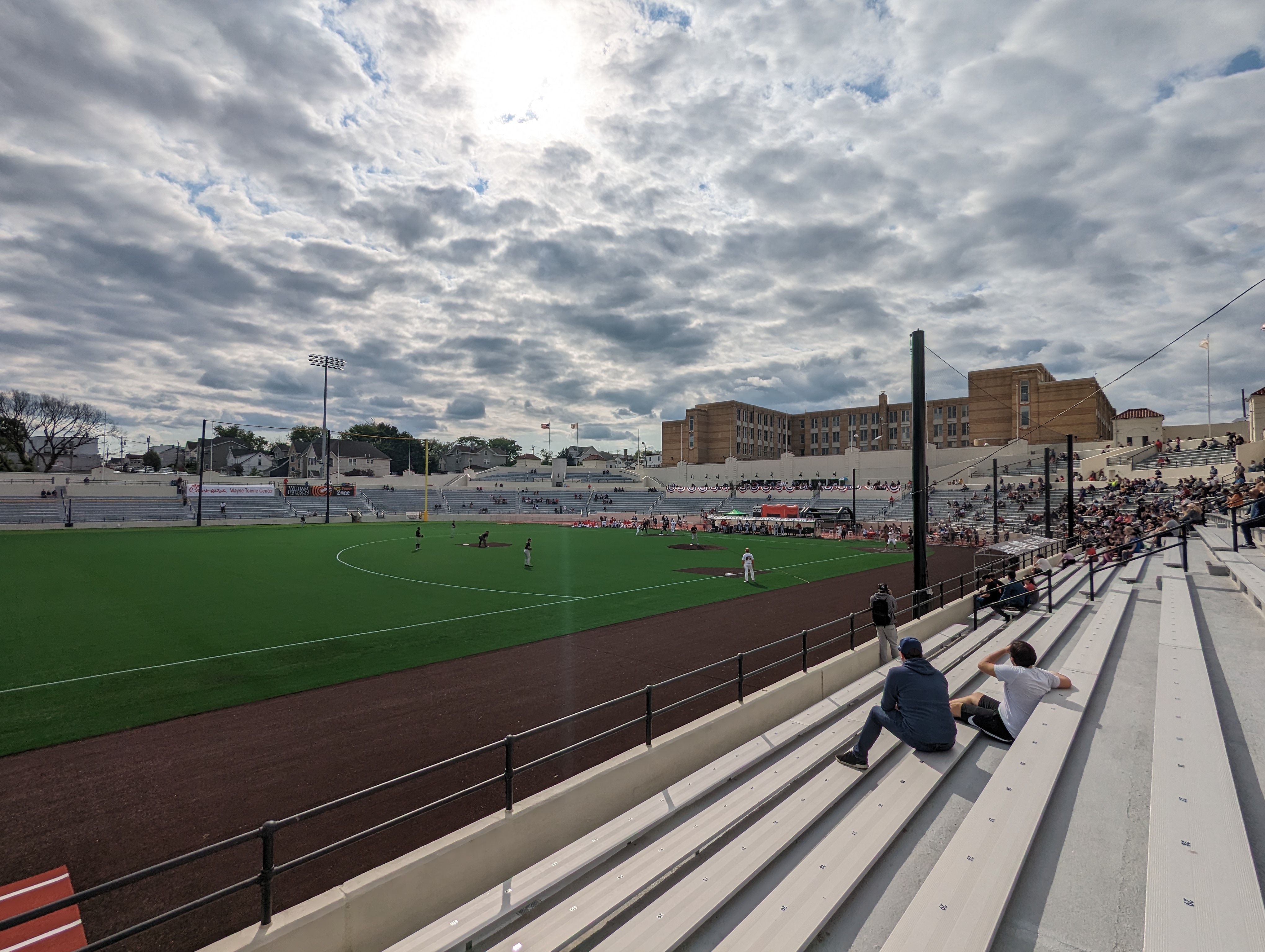
After decades of neglect, Hinchliffe Stadium was renovated and became the home field for the New Jersey Jackals of the Frontier League, an MLB Partner League, in 2023.
Downs Field - Austin, Texas
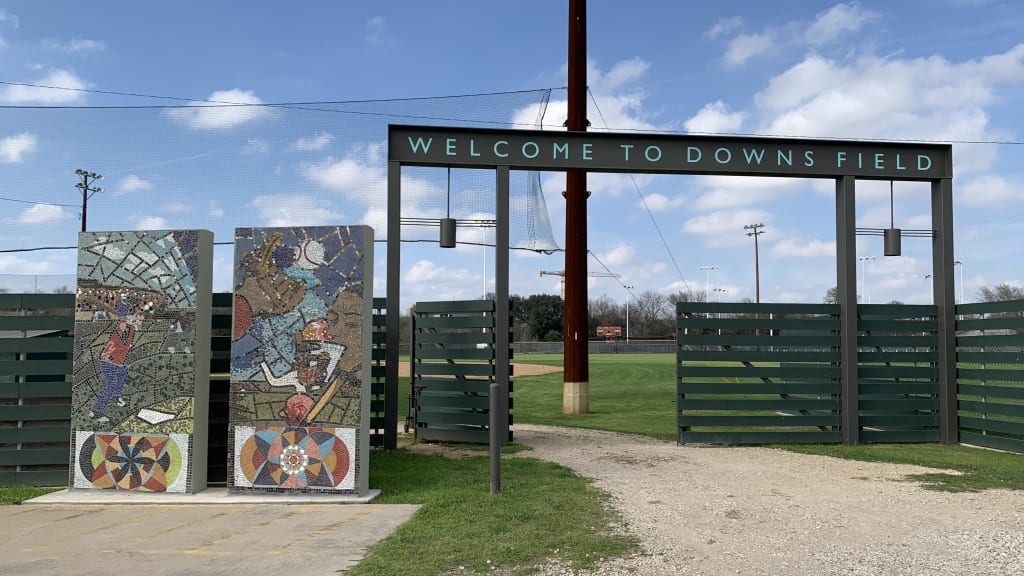
One of the most beautiful fields still in existence, and currently used by the Huston-Tillotson Rams college baseball team, is Downs Field. The Austin ballpark played host to some of the best players in Negro Leagues history. The Texas Black Senators, a Minor Negro Leagues team, played here as a member of the Texas Colored League. Hall of Fame shortstop Willie Wells began his career with Texas, before moving on to his best-known years with the St. Louis Stars. Players like Paige, Mays, Smokey Joe Williams and Buck O'Neil also came through the city for games on the field, and their impact is noted by a series of tiled murals by local artists to commemorate the space.
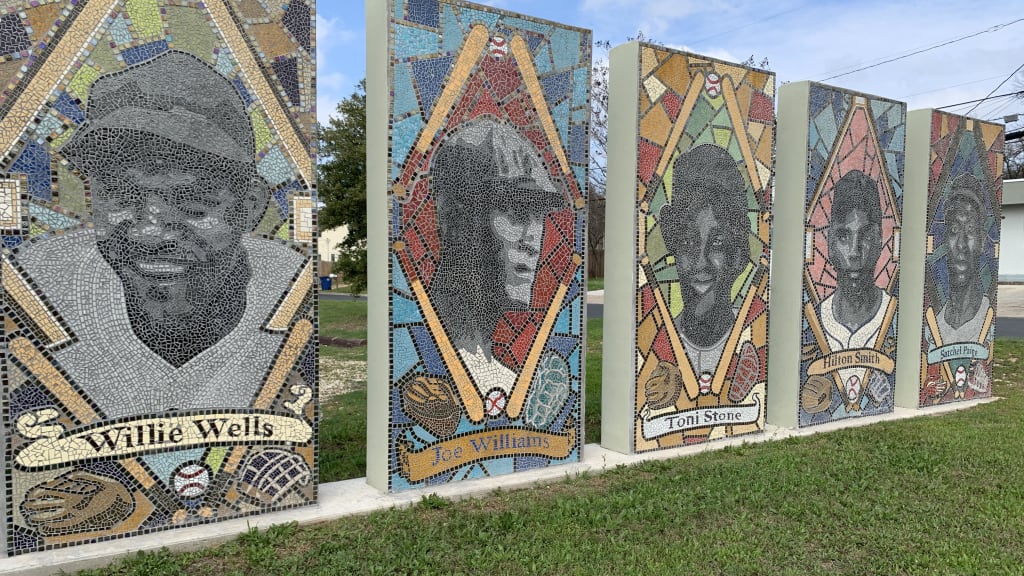
Red Cap Stadium - Jacksonville, Fla.
Now known as J.P. Small Memorial Stadium -- but called Durkee Field (and briefly Red Cap Stadium) in its heyday -- this ballpark housed the short-lived Jacksonville Red Caps in 1938 and from 1941-42. (They would continue playing as Minor League team after World War II.)
Renovated in the early 2000s, the field is still in use and has a small Negro Leagues exhibit inside with a statue of Buck O'Neil outside the gates.
Stadium Lofts - Indianapolis, Ind.
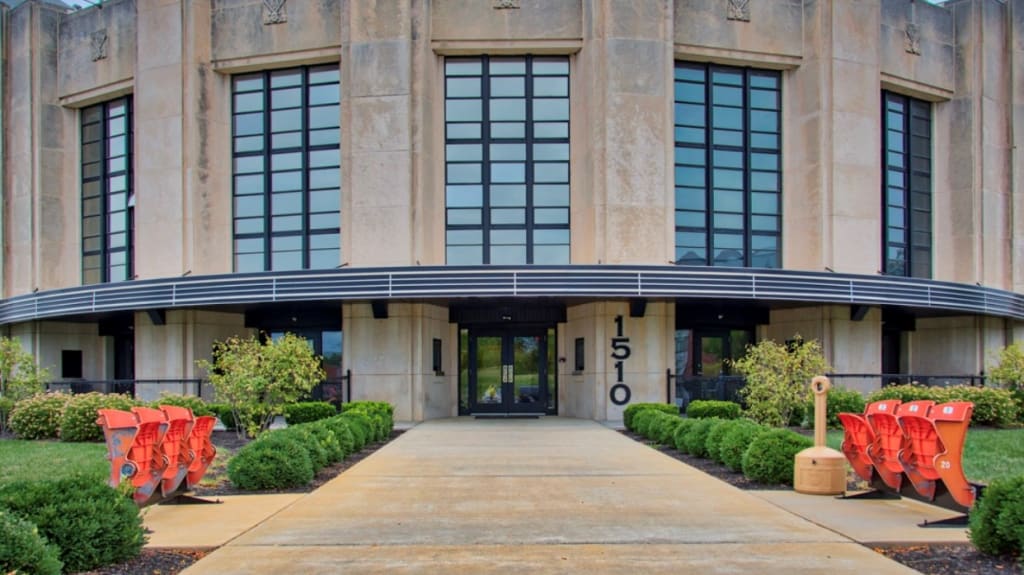
While most of the Negro Leagues stadiums have been torn down and replaced, this one is a little different. Instead of tearing down Bush Stadium, this apartment complex was built to honor the stadium. Now your home could be in the same place where Hank Aaron, Oscar Charleston and String Bean Williams took the field while playing for the Clowns and ABCs.
The structure of the stadium has been kept in place, giving an absolutely cathedral-like entrance to your home. Even better: Look out your window and there’s still a baseball field as your backyard. You can almost picture the Clowns winning the 1950 championship on this field if you think hard enough.
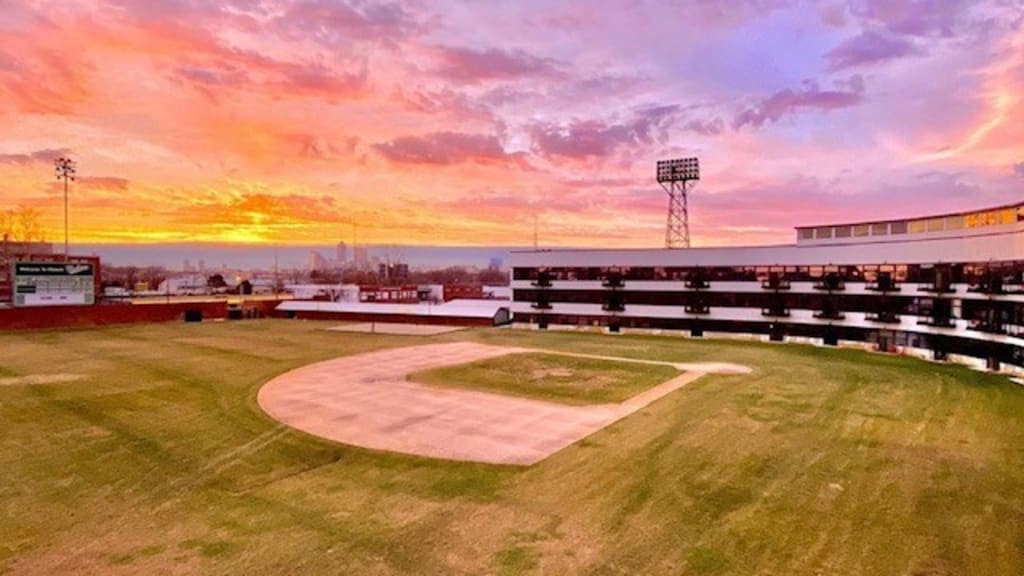
Judy Johnson’s house - Marshallton, Del.
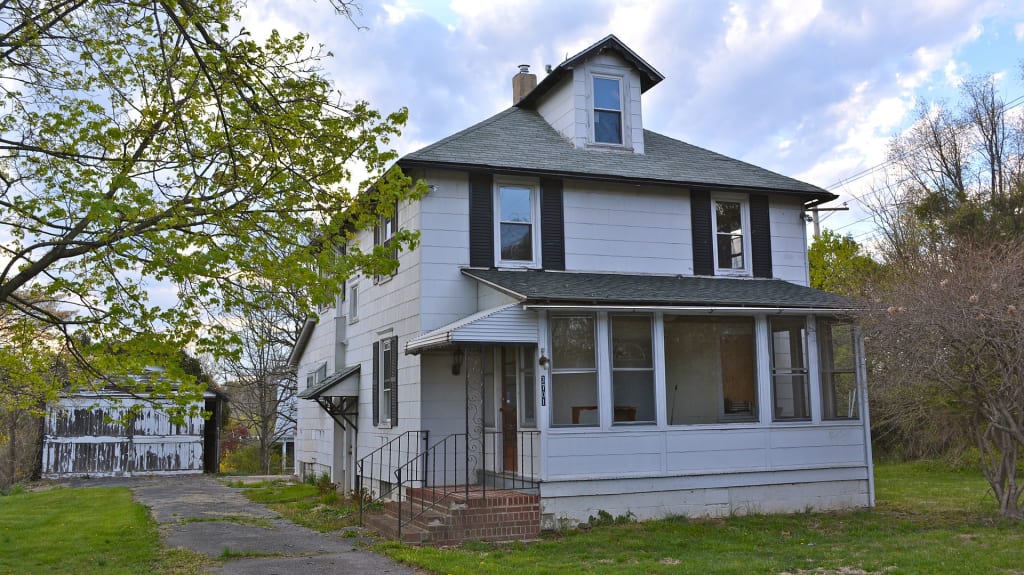
Judy Johnson was arguably the greatest third baseman in the history of the Negro Leagues, with Arthur Ashe calling him, “the standard by which other third basemen were measured.”
You can see the place he called his home with his wife Anita from 1934 until shortly before his death in 1989. After seeing the house, drive over to see the statue of Johnson that resides outside Frawley Stadium -- home of the High-A Blue Rocks -- in nearby Wilmington.
Cool Papa Bell Marker - Starkville, Miss.
Cool Papa Bell may be one of the fastest people to ever walk -- er, run -- on the face of the planet. It was said that he was so fast, he could turn out the light and be in bed before the room got dark.
But even the greatest players have to come from somewhere, and so his hometown of Starkville has a marker honoring his skills. You can find this one by the McKee Park ballfield, located off Lynn Lane.
Because Bell’s best period of play was with the St. Louis Stars, there is also a star with his name on it in the St. Louis Walk of Fame, along with a large tombstone designed by his daughter in a nearby cemetery.
History of African-American baseball marker - Philadelphia
At the intersection of Belmont & Parkside Avenues stands a marker in honor of the African-American ballplayers and clubs who hailed from Philadelphia.
That includes the Philadelphia Giants, which formed in 1902 and won five of six championships from 1904-09; the Hilldale Club, which featured Judy Johnson, Oscar Charleston and Biz Mackey among others; and the Philadelphia Stars, which featured Mackey and Jud Wilson and were the final Negro Leagues team that Paige pitched for in 1950. The marker also stands near the Parkside Ballpark that the Stars called their home.
Hank Aaron's childhood home - Mobile, Ala.
Originally built by Hank's father, Herbert, in 1942 in the Toulminville area of Mobile, the family home was moved to the site of Hank Aaron Stadium in 2008 -- where the Mobile BayBears played. There, the house was converted into a museum honoring Hank Aaron's legendary career. Stuffed full of memorabilia, it includes materials from his short one-season stint with the Indianapolis Clowns in 1952.
When the BayBears left Mobile to become the Rocket City Trash Pandas in Madison, Ala., following the 2019 season, the city -- which owns the house -- relocated it back to the Toulminville neighborhood, though it remains closed to tours.
Buck O'Neil Education and Research Center - Kansas City
It may be named after Buck O'Neil now, but the building -- and its original awning -- was the Paseo YMCA. It was here in 1920 that Andrew "Rube" Foster and a handful of other Midwestern team owners met and formed the Negro National League. From there, the Negro Leagues blossomed with separate leagues beginning in the eastern and southern United States.
In 2023, the Negro Leagues Baseball Museum announced plans to build a new facility adjacent to the historic site.
Ponce de Leon Park - Atlanta
Sadly, the original stadium for the Atlanta Black Crackers is long gone, but don't despair. While the field no longer exists, having been paved over long ago, you can still pay homage to the team that played at Ponce de Leon Park from 1919-38. That's because the Magnolia trees that were part of the grounds in center field are still standing inside a parking lot.
Jackie Robinson's birthplace - Cairo, Ga.
Keep your eyes peeled while driving through the town of Cairo. Because there, on Hadley Ferry Road, north of Meridian Road, you'll find the place where the great Jackie Robinson was born. Only the chimney remains after the house burned down in 1996, but a marker was erected to commemorate the site in 2001.
Homestead Grays plaque - Homestead, Pa.
They are arguably the greatest team -- regardless of race -- to ever walk the face of the planet. Led by players like Josh Gibson, Jud "Boojum" Wilson, Smokey Joe Williams and others, they were a near unstoppable force.
Though the field they played upon is long gone, a marker remains at the corner of Amity and East 5th Streets in Homestead, and you can just imagine the dingers that Gibson would have hit flying over your head.
